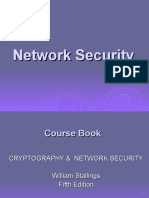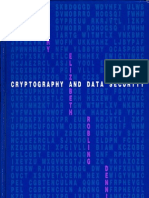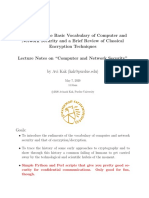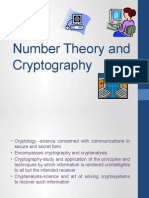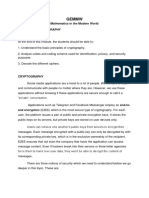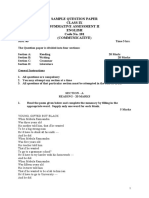0 ratings0% found this document useful (0 votes)
61 viewsLecture 1-Introduction and Encryption Methods
This document provides an introduction to data encryption techniques and standards. It discusses symmetric and asymmetric encryption methods. Symmetric encryption uses a shared secret key for encryption and decryption, while asymmetric encryption uses different keys. It also describes common cryptographic concepts like plaintext, ciphertext, encryption algorithms, decryption algorithms, secret keys, ciphers, cryptography, and cryptanalysis. Specific encryption methods and ciphers covered include substitution ciphers, transposition ciphers, block ciphers, stream ciphers, the Data Encryption Standard (DES), Triple DES, and the Advanced Encryption Standard (AES).
Uploaded by
sameer15112000Copyright
© © All Rights Reserved
We take content rights seriously. If you suspect this is your content, claim it here.
Available Formats
Download as PDF, TXT or read online on Scribd
0 ratings0% found this document useful (0 votes)
61 viewsLecture 1-Introduction and Encryption Methods
This document provides an introduction to data encryption techniques and standards. It discusses symmetric and asymmetric encryption methods. Symmetric encryption uses a shared secret key for encryption and decryption, while asymmetric encryption uses different keys. It also describes common cryptographic concepts like plaintext, ciphertext, encryption algorithms, decryption algorithms, secret keys, ciphers, cryptography, and cryptanalysis. Specific encryption methods and ciphers covered include substitution ciphers, transposition ciphers, block ciphers, stream ciphers, the Data Encryption Standard (DES), Triple DES, and the Advanced Encryption Standard (AES).
Uploaded by
sameer15112000Copyright
© © All Rights Reserved
We take content rights seriously. If you suspect this is your content, claim it here.
Available Formats
Download as PDF, TXT or read online on Scribd
You are on page 1/ 15
Sanjivani Rural Education Society’s
Sanjivani College of Engineering, Kopargaon-423 603
(An Autonomous Institute, Affiliated to Savitribai Phule Pune University, Pune)
NACC ‘A’ Grade Accredited, ISO 9001:2015 Certified
Department of Computer Engineering
(NBA Accredited)
UNIT-2: Data Encryption Techniques and Standards
Lecture-01 Introduction
Prof. P.M. Dhanrao
Assistant Professor
E-mail : dhanraopravincomp@sanjivani.org.in
Contact No: 9028526256
Contents
• Introduction,
• Encryption Methods: Symmetric, Asymmetric,
• Cryptography,
• Substitution Ciphers.
• Transposition Ciphers,
• Stenography applications and limitations,
• Block Ciphers and methods of operations,
• Feistal Cipher,
• Data Encryption Standard (DES),
• Triple DES,
• DES Design Criteria, Weak Keys in DES Algorithms,
• Advance Encryption Standard (AES).
DEPARTMENT OF COMPUTER ENGINEERING , SCOE,KOPARGAON 2
Basic terminology
• Plaintext: original message to be encrypted
• Ciphertext: the encrypted message
• Enciphering or encryption: the process of converting plaintext into ciphertext
• Encryption algorithm: performs encryption
• Two inputs: a plaintext and a secret key
DEPARTMENT OF COMPUTER ENGINEERING , SCOE,KOPARGAON 3
• Deciphering or decryption: recovering plaintext from ciphertext
• Decryption algorithm: performs decryption
• Two inputs: ciphertext and secret key
• Secret key: same key used for encryption and decryption
• Also referred to as a symmetric key
DEPARTMENT OF COMPUTER ENGINEERING , SCOE,KOPARGAON 4
• Cipher or cryptographic system : a scheme for encryption and decryption
• Cryptography: science of studying ciphers
• Cryptanalysis: science of studying attacks against cryptographic systems
• Cryptology: cryptography + cryptanalysis
DEPARTMENT OF COMPUTER ENGINEERING , SCOE,KOPARGAON 5
Ciphers
• Symmetric cipher: same key used for encryption and decryption
• Block cipher: encrypts a block of plaintext at a time (typically 64 or 128 bits)
• Stream cipher: encrypts data one bit or one byte at a time
• Asymmetric cipher: different keys used for encryption and decryption
DEPARTMENT OF COMPUTER ENGINEERING , SCOE,KOPARGAON 6
Symmetric Encryption
• or conventional / private-key / single-key
• sender and recipient share a common key
• all classical encryption algorithms are private-key
• was only type prior to invention of public-key in 1970’s
• and by far most widely used
DEPARTMENT OF COMPUTER ENGINEERING , SCOE,KOPARGAON 7
Symmetric Cipher Model
DEPARTMENT OF COMPUTER ENGINEERING , SCOE,KOPARGAON 8
Requirements
• two requirements for secure use of symmetric encryption:
• a strong encryption algorithm
• a secret key known only to sender / receiver
• mathematically have:
Y = EK(X)
X = DK(Y)
• assume encryption algorithm is known
• implies a secure channel to distribute key
DEPARTMENT OF COMPUTER ENGINEERING , SCOE,KOPARGAON 9
Cryptography
• characterize cryptographic system by:
• type of encryption operations used
• substitution / transposition / product
• number of keys used
• single-key or private / two-key or public
• way in which plaintext is processed
• block / stream
DEPARTMENT OF COMPUTER ENGINEERING , SCOE,KOPARGAON 10
Cryptanalysis
• objective to recover key not just message
• general approaches:
• cryptanalytic attack
• brute-force attack
DEPARTMENT OF COMPUTER ENGINEERING , SCOE,KOPARGAON 11
Cryptanalytic Attacks
• ciphertext only
• only know algorithm & ciphertext, is statistical, know or can identify plaintext
• known plaintext
• know/suspect plaintext & ciphertext
• chosen plaintext
• select plaintext and obtain ciphertext
• chosen ciphertext
• select ciphertext and obtain plaintext
• chosen text
• select plaintext or ciphertext to en/decrypt
DEPARTMENT OF COMPUTER ENGINEERING , SCOE,KOPARGAON 12
More Definitions
• unconditional security
• no matter how much computer power or time is available, the cipher cannot be
broken since the ciphertext provides insufficient information to uniquely determine
the corresponding plaintext
• computational security
• given limited computing resources (eg time needed for calculations is greater than
age of universe), the cipher cannot be broken
DEPARTMENT OF COMPUTER ENGINEERING , SCOE,KOPARGAON 13
Brute Force Search
• always possible to simply try every key
• most basic attack, proportional to key size
• assume either know / recognise plaintext
Key Size (bits) Number of Time required at 1 Time required at 106
Alternative Keys decryption/µs decryptions/µs
32 232 = 4.3 109 231 µs = 35.8 minutes 2.15 milliseconds
56 256 = 7.2 1016 255 µs = 1142 years 10.01 hours
128 2128 = 3.4 1038 2127 µs = 5.4 1024 5.4 1018 years
years
168 2168 = 3.7 1050 2167 µs = 5.9 1036 5.9 1030 years
years
26 characters 26! = 4 1026 2 1026 µs = 6.4 1012 6.4 106 years
(permutation) years
DEPARTMENT OF COMPUTER ENGINEERING , SCOE,KOPARGAON 14
THANK YOU
You might also like
- Advanced Computer Networks & Computer and Network Security: Prof. Dr. Hasan Hüseyin BALIK (2 Week)No ratings yetAdvanced Computer Networks & Computer and Network Security: Prof. Dr. Hasan Hüseyin BALIK (2 Week)34 pages
- Cryptography and Cryptographic AlgorithmsNo ratings yetCryptography and Cryptographic Algorithms36 pages
- Lectures 13 To 15 - Cryptography Details Symmetric EncryptionNo ratings yetLectures 13 To 15 - Cryptography Details Symmetric Encryption31 pages
- University Institute of Engineering Bachelor of Engineering (Computer Science & Engineering) Operating SystemNo ratings yetUniversity Institute of Engineering Bachelor of Engineering (Computer Science & Engineering) Operating System14 pages
- WINSEM2023-24_BCSE309L_TH_VL2023240500759_2024-01-12_Reference-Material-INo ratings yetWINSEM2023-24_BCSE309L_TH_VL2023240500759_2024-01-12_Reference-Material-I57 pages
- Implementation of Aes and Blowfish AlgorithmNo ratings yetImplementation of Aes and Blowfish Algorithm4 pages
- Introduction To Symmetric Block Cipher: Jing DengNo ratings yetIntroduction To Symmetric Block Cipher: Jing Deng18 pages
- Sécurité de L'information: La Date: 21 / 10 /2020No ratings yetSécurité de L'information: La Date: 21 / 10 /20208 pages
- Network Security: CS 6823 - Lecture 5 CryptographyNo ratings yetNetwork Security: CS 6823 - Lecture 5 Cryptography66 pages
- LECT 4 - Foundations of Cryptography Cont.No ratings yetLECT 4 - Foundations of Cryptography Cont.33 pages
- Block Ciphers and Block Ciphers and Encryption Standards Encryption StandardsNo ratings yetBlock Ciphers and Block Ciphers and Encryption Standards Encryption Standards47 pages
- Cryptography Basics for New Coders: A Practical Guide with ExamplesFrom EverandCryptography Basics for New Coders: A Practical Guide with ExamplesNo ratings yet
- Transformation of Cryptography: Fundamental concepts of Encryption, Milestones, Mega-Trends and sustainable Change in regard to Secret Communications and its NomenclaturaFrom EverandTransformation of Cryptography: Fundamental concepts of Encryption, Milestones, Mega-Trends and sustainable Change in regard to Secret Communications and its NomenclaturaNo ratings yet
- Classsical Encryption Techniques MukeshNo ratings yetClasssical Encryption Techniques Mukesh13 pages
- Fall Semester 2024-25 - MAT1007 - TH - AP2024252000162 - 2024-09-11 - Reference-Material-IINo ratings yetFall Semester 2024-25 - MAT1007 - TH - AP2024252000162 - 2024-09-11 - Reference-Material-II13 pages
- (Ebook) Innovative cryptography by Nick Moldovyan, Alex Moldovyan ISBN 9781584504672, 9781584506546, 1584504676, 1584506547 2024 Scribd DownloadNo ratings yet(Ebook) Innovative cryptography by Nick Moldovyan, Alex Moldovyan ISBN 9781584504672, 9781584506546, 1584504676, 1584506547 2024 Scribd Download76 pages
- Modern Cryptography - Applied Ma - Chuck Easttom67% (3)Modern Cryptography - Applied Ma - Chuck Easttom505 pages
- Gemmw: Mathematics in The Modern World Module 5: Cryptography Learning OutcomesNo ratings yetGemmw: Mathematics in The Modern World Module 5: Cryptography Learning Outcomes15 pages
- VHDL Code For The Data Encryption StandardNo ratings yetVHDL Code For The Data Encryption Standard66 pages
- Chapter 7: String Manipulation Exercises: Namedept ('Robert','Mechanical')No ratings yetChapter 7: String Manipulation Exercises: Namedept ('Robert','Mechanical')17 pages
- Sample Question Paper Class Ix Summative Assessment Ii English Code No. 101 (Communicative)No ratings yetSample Question Paper Class Ix Summative Assessment Ii English Code No. 101 (Communicative)16 pages
- Cryptography and Advanced Computer Security (CENG625)No ratings yetCryptography and Advanced Computer Security (CENG625)77 pages
- (ISC)2 Cybersecurity Course Terms and Definitions (1)No ratings yet(ISC)2 Cybersecurity Course Terms and Definitions (1)18 pages

